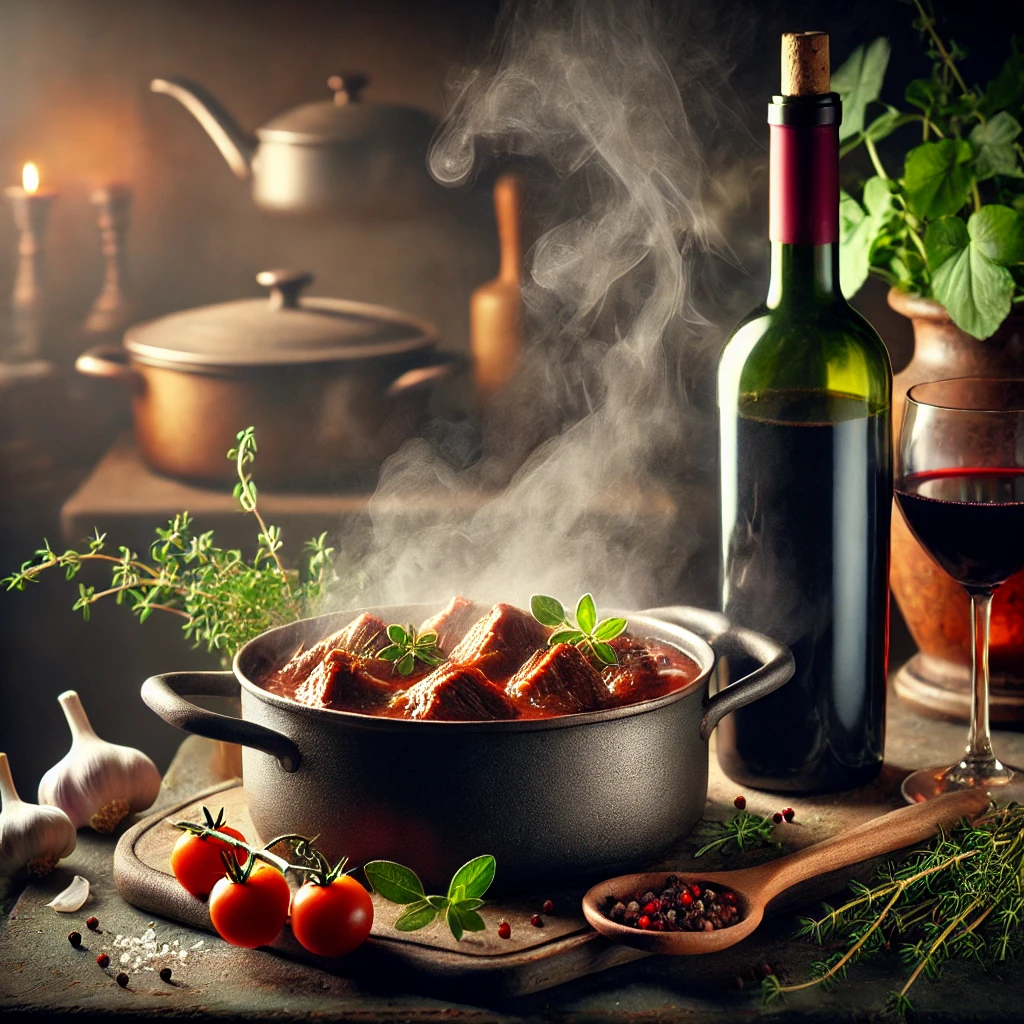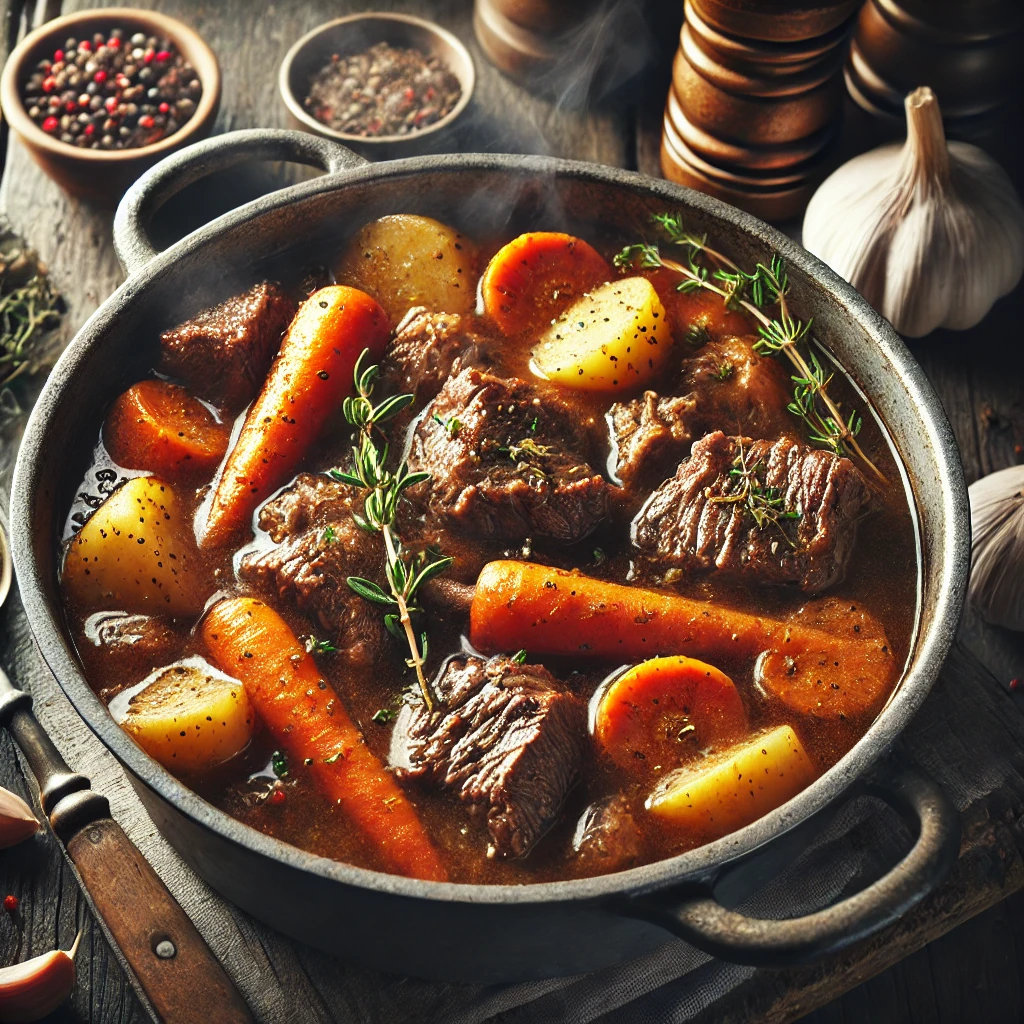Table of contents
- Introduction
- Key Elements of a Flavorful Beef Stew
- Alternative Ingredient Upgrades
- How to Use This Ingredient Effectively
- Frequently Asked Questions (FAQs)
- 1. What is the one ingredient upgrade for better beef stew?
- 2. Can I skip red wine in beef stew?
- 3. How does red wine improve the flavor of beef stew?
- 4. What type of red wine is best for beef stew?
- 5. Can I add wine at the end of cooking?
- 6. Are there dietary-friendly alternatives to red wine?
- 7. How do I fix an overpowering wine flavor?
- 8. Should I use cooking wine or regular wine?
- 9. How much red wine should I use in a stew?
- 10. Can I make beef stew ahead of time?
- Conclusion: Elevate Your Beef Stew with One Ingredient
Introduction
A warm, hearty beef stew is the ultimate comfort food, but even the most classic recipes can benefit from a small enhancement. With just one carefully chosen ingredient, you can take your beef stew seasoning recipe from good to unforgettable.
This article explores the one ingredient upgrade that makes a significant difference in flavor, texture, and aroma. Whether you’re aiming for a richer broth or a more balanced dish, this secret addition will transform your beef stew into a masterpiece.
Key Elements of a Flavorful Beef Stew
Creating a delicious beef stew starts with understanding the essential components that build its flavor. From the broth to the seasoning, each element plays a crucial role. The addition of one upgraded ingredient can amplify these components, turning your stew into an unforgettable dish.
The Broth
The broth is the foundation of any stew. A rich, well-seasoned broth binds all the flavors together, ensuring every bite is packed with depth and warmth. Using homemade beef stock or high-quality store-bought broth enhances the base flavor.
Pro Tip: Deglaze your pan with wine, vinegar, or broth after browning the beef to incorporate the caramelized bits into the stew.
The Beef
Tender, flavorful beef is the heart of the dish. Cuts like chuck roast, brisket, or short ribs are ideal because their marbling breaks down during slow cooking, infusing the stew with richness.
Pro Tip: Season the beef with salt and pepper and sear it before adding to the stew for a deeper flavor.
The Vegetables
Carrots, onions, celery, and potatoes are the classic choices for beef stew. These vegetables add texture and sweetness, complementing the savory flavors of the broth and meat.
- Onions and Garlic: Provide a savory, aromatic base.
- Root Vegetables: Add natural sweetness and heartiness.
Pro Tip: Roast the vegetables before adding them to the stew for enhanced flavor.
The Seasoning
A good beef stew seasoning recipe includes a balance of herbs and spices:
- Herbs: Thyme, rosemary, and bay leaves for earthy, aromatic notes.
- Spices: Paprika or black pepper for subtle heat and depth.
Balancing salt, acidity, and sweetness ensures a well-rounded flavor. The right seasoning sets the stage for introducing the upgraded ingredient that will take your stew to the next level.
What Is the One Ingredient Upgrade for Better Beef Stew?
The secret to elevating a beef stew lies in a single, carefully chosen ingredient that adds depth, complexity, and balance. While many ingredients can enhance a stew, red wine stands out as the ultimate upgrade for better flavor.
Why Red Wine?

Red wine introduces rich, bold flavors that enhance every component of the stew. Its acidity balances the richness of the beef, while its fruity and tannic notes add complexity to the broth. When simmered, the wine melds with the other ingredients, creating a harmonious blend of flavors.
- Depth: Adds layers of savory and fruity flavors.
- Balance: Cuts through the fat of the beef, making the dish lighter on the palate.
- Aroma: Contributes a fragrant, sophisticated aroma.
How to Choose the Right Red Wine
Not all wines are created equal when it comes to cooking. Choose wines that complement the hearty flavors of beef stew.
- Dry Reds:
- Cabernet Sauvignon, Merlot, or Pinot Noir are excellent choices.
- Avoid sweet wines, which can overpower the dish.
- Affordable Options:
- Use a wine you enjoy drinking but don’t splurge on an expensive bottle. Cooking reduces some of the wine’s nuances.
How to Use Red Wine in Beef Stew
- Deglaze the Pan:
- After browning the beef, pour in the red wine to deglaze the pan. This loosens the caramelized bits and infuses the stew with flavor.
- Simmer Early:
- Add the wine to the broth early in the cooking process. This allows the alcohol to cook off and the flavors to integrate.
- Start with 1 Cup:
- Begin with one cup of wine for a standard-sized stew. Adjust based on taste and the volume of liquid.
Alternative Ingredient Upgrades

If red wine isn’t an option, try these substitutes for a similar flavor boost:
- Balsamic Vinegar:
- Adds tanginess and a subtle sweetness.
- Pomegranate Juice:
- Mimics the acidity and fruity notes of red wine.
- Soy Sauce or Worcestershire Sauce:
- Boosts umami flavors without altering the stew’s profile significantly.
With red wine as your secret ingredient, you can transform your beef stew into a gourmet dish that wows every time. Up next, we’ll discuss how to use this ingredient effectively to maximize its impact.
How to Use This Ingredient Effectively
Incorporating red wine into beef stew requires careful attention to timing and technique. When used correctly, it enhances the dish without overpowering other flavors. Here’s how to make the most of this secret ingredient.
Timing is Everything
- Early in the Cooking Process:
- Add the red wine after browning the beef or sautéing the vegetables. This allows the alcohol to cook off while retaining the wine’s depth and complexity.
- Cooking it longer ensures the wine integrates seamlessly into the broth.
- Adjusting Towards the End:
- For a stronger wine flavor, reserve a small amount to stir into the stew 10–15 minutes before serving.
Pairing Red Wine with Other Ingredients
- With Herbs and Spices:
- Red wine pairs beautifully with herbs like thyme, rosemary, and bay leaves.
- Complement it with spices like paprika or black pepper for a warm, rounded flavor.
- With Vegetables:
- The acidity in red wine enhances the sweetness of root vegetables like carrots, parsnips, and onions.
- With Broth:
- A combination of red wine and beef stock creates a balanced, savory base for the stew.
Tips for Enhancing Flavor Without Overdoing It
- Use Moderation:
- Start with 1 cup of red wine for a standard stew. Too much wine can overpower the other flavors and make the dish acidic.
- Deglaze for Extra Flavor:
- Use wine to deglaze the pan after searing the beef. This adds caramelized depth to the stew.
- Taste as You Go:
- Regularly taste the stew as it simmers to adjust the seasoning and wine balance.
Substitute Wisely When Needed
If you don’t have red wine or prefer not to use alcohol, consider these alternatives:
- Balsamic Vinegar:
- Use 1–2 tablespoons for tanginess and mild sweetness.
- Pomegranate or Grape Juice:
- Mimics wine’s fruity and acidic notes. Adjust sweetness with a pinch of salt or lemon juice.
- Tomato Paste with Stock:
- A blend of tomato paste and beef stock provides a rich, umami-packed alternative.
Frequently Asked Questions (FAQs)
1. What is the one ingredient upgrade for better beef stew?
Red wine is often considered the ultimate ingredient upgrade for beef stew. Its depth, acidity, and complex flavors enhance the dish, creating a rich and satisfying broth.
2. Can I skip red wine in beef stew?
Yes, you can skip red wine if needed. Alternatives like balsamic vinegar, pomegranate juice, or a mix of tomato paste and beef stock can provide similar depth and balance.
3. How does red wine improve the flavor of beef stew?
Red wine adds richness and complexity, balancing the stew’s flavors with its acidity while complementing the savory notes of beef and vegetables.
4. What type of red wine is best for beef stew?
Dry red wines such as Cabernet Sauvignon, Merlot, or Pinot Noir work best for beef stew. Avoid sweet wines as they can disrupt the flavor balance.
5. Can I add wine at the end of cooking?
Adding wine at the end provides a bolder wine flavor, but it won’t integrate as seamlessly as when added early. If you prefer this approach, use only a small amount.
6. Are there dietary-friendly alternatives to red wine?
Yes! Non-alcoholic options like balsamic vinegar, grape juice, or alcohol-free red wine are excellent substitutes that maintain the dish’s balance and depth.
7. How do I fix an overpowering wine flavor?
If the stew has too much wine flavor:
- Let it simmer longer to reduce the acidity.
- Add a pinch of sugar or honey to balance the taste.
- Dilute with additional broth.
8. Should I use cooking wine or regular wine?
Always opt for regular drinking wine over cooking wine. Cooking wine often contains added salt and lacks the nuanced flavors that elevate the stew.
9. How much red wine should I use in a stew?
Start with 1 cup of red wine for a standard-sized stew. Adjust based on your preference and the volume of liquid in the dish.
10. Can I make beef stew ahead of time?
Absolutely! Beef stew tastes even better the next day as the flavors meld together. Store it in an airtight container in the refrigerator for up to 3 days or freeze for longer storage.
Conclusion: Elevate Your Beef Stew with One Ingredient
The addition of red wine—or its substitutes—can transform your beef stew into a dish that’s rich, flavorful, and unforgettable. By understanding how to use this ingredient effectively and pairing it with complementary flavors, you’ll elevate your stew to gourmet levels.
Experiment with this upgrade in your next beef stew seasoning recipe and watch as your guests savor every bite. Small changes can make a big difference—so don’t be afraid to get creative and make the dish your own!


1 thought on “What is the one ingredient upgrade for better beef stew?”